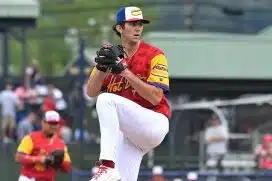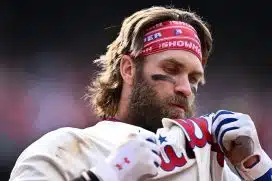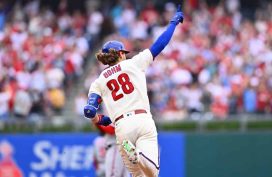By Robert Orr, Sports Talk Philly Contributor
After the arbitration non-tenders for Maikel Franco and César Hernandez ended their time with the Phillies, the club was always destined for a makeover in their starting infield. Incumbent shortstop Jean Segura had also been involved in some trade rumors and a position change had been suggested, meaning three out of the four infield spots were in doubt. The picture is much clearer now that the Phillies have signed former Yankees shortstop Didi Gregorius.
Gregorius will be the team’s everyday shortstop, Segura will slide over to the less-demanding position of second base, and Scott Kingery should replace Franco at third base – at least until top prospect Alec Bohm arrives from Lehigh Valley. Rhys Hoskins, of course, will remain the first baseman and hope to have a more consistent season than he did last year.
Gregorius is the best shortstop this team will have had since Jimmy Rollins was in his prime. The athletic lefty had an abbreviated 2019 after returning from a UCL tear he suffered at the end of 2018, but his production in the prior 2 seasons was phenomenal; he outproduced every shortstop the team has had since trading Rollins in that time.
Gregorius in 2017-18: .277/.326/.486 slash line with a 115 wRC+ and 8.8 fWAR.
Phillies SS from 2015-2019: .250/.297/.377 slash line with a 78 wRC+ and 8.7 fWAR.
Gregorius's bat figures to be an enormous addition to this team. But how will the new infield perform in the field? The Phillies of 2019 were better defensively than some might have thought: they were sixth in fangraphs’ UZR/150 – a defensive metric that measures how well a player fields his position by counting individual components such as his range, errors, double play conversion (for middle infielders) and his arm, then scales the results to 150 chances.
The final number is meant to show how many runs a player saves (or costs) his team in the field. After the defensive disaster of 2018, when the team posted a -8.0 UZR/150 – by far the worst in baseball – their 3.4 UZR/150 in 2019 was an enormous improvement. But can this new infield configuration be even better?
Starting with the new guy, Gregorius, is most well-known for being a lefty power bat who rarely strikes out, but he’s also very capable in the field. He’s had multiple seasons that have graded out as above average defensively – particularly performing well in the errors and range components of UZR over the course of his career. He’s a sure glove that covers a lot of ground, as you might expect from a 6’3” shortstop.
One area of some concern: in 2019 Gregorius was -6 in Defensive Runs Saved, another popular defensive metric, and just barely average in UZR/150, but he had just returned from Tommy John surgery after a mere eight months of recovery. The odds are that he rebounds and replicates his 2017 and 2018 performance in the field and at the plate, and he seemed to be returning to that level in October with the Yankees.
Adding Gregorius allows the possibility of moving Segura to the less-demanding defensive position of second base. Segura has played there before; he spent nearly an entire season at second base in 2016 when he was with the Diamondbacks, performing at a roughly average level, with 0 Defensive Runs Saved in over 1100 innings and a slightly negative UZR.
Compare that to his 2019 performance at short with the Phillies, when he was -5 in defensive runs saved, and you begin to see why this move would make sense for him the Phillies. It’s a basic metric, but Segura had the fourth-most errors in all of baseball in 2019 with 20. Compare this to Gregorius, who had 21 errors total in 2017, 2018, and 2019 combined. In an ideal world, Jean would have much less to do with his glove in 2020.
The remaining questions then would be what to do at third base, and what happens with Kingery? These two are inextricably linked. With the team presumably relying on top prospect Bohm to contribute sooner rather than later in 2020, signing a permanent third baseman would be a waste of resources. The likely solution is to play Kingery there as a stopgap until Bohm is ready, then continuing Kingery in his super-utility role and using him as the main bat off the bench when he doesn’t start. Small sample sizes are dangerous – especially when it comes to defensive statistics – but Kingery’s numbers as a third baseman are incredible; 8 DRS in only 306 innings there in 2019, to go along with a 16.7 UZR/150.
To put that into context, Nolan Arenado, winner of seven consecutive gold gloves, had eight DRS in 1319 innings last year. Andrelton Simmons, arguably the best defender of the decade, has a career 17.4 UZR/150. Will Kingery be a perennial gold glover or generational infield defender while manning third? Almost definitely not, but he potentially could be an elite defender at the position and going from the very limited Maikel Franco at third to Kingery might be the biggest upgrade the Phillies have made this offseason.
A significant benefit to having Kingery man the hot corner is that it opens a host of shifting opportunities for the Phillies to deploy, particularly against lefty hitters. For a team with no lefty starters and whose best lefty reliever – Adam Morgan – is dealing with serious injury questions, being able to align two shortstop-like defenders in Gregorius and Segura on the pull side of the infield against left-handed hitters could be a difference-maker. Kingery’s exceptional range as the third baseman would create this possibility.
In previous seasons you might recall Carlos Santana or Franco standing in the normal shortstop position, covering the entire left side of the infield alone while the shift was on. This did not always end well for the Phillies; left-handed hitters had the fifth best average on ball in play against Phillies pitching over the last two seasons and tied for the third-highest slugging percentage. Long story short, when lefties hit against Phillies pitching, they did damage. Being able to align better fielders in better positions can help to counteract that.
The Phillies rotation stands to greatly benefit from the remodeled infield. The staff induced the ninth-highest rate of ground balls in MLB last year at 44.55%, per Baseball Prospectus, and the addition of Zack Wheeler and his career 46.5% ground ball rate only figures to increase that number. This is a staff that pitches to soft contact, with pitchers like Zach Eflin and Jake Arrieta heavily reliant on the fielders behind them. With Segura at a better spot for his skills and the rangy pair of Gregorius and Kingery at short and third, a mostly disappointing rotation last year could have a better showing in 2020.
This infield will have at least one change mid-season at some point next year, when the team’s top prospect Bohm makes his way up to the big leagues. Bohm’s bat could be a real boost for the lineup – he had a 160 wRC+ across 3 levels in the minors last year – but there are questions about his ability to field his position, and some have even speculated that he may end up a first baseman or left fielder long-term. Given these concerns, there might be some days after Bohm comes up where manager Joe Girardi opts to play Kingery at third, such as when sinker ballers Eflin or Arrieta are on the mound.
The Phillies’ defense was pretty good last year. Due mostly to the superhuman efforts of J.T. Realmuto behind the plate and excellent showings in the outfield by Bryce Harper, Adam Haseley, and Andrew McCutchen, the team ended up with the fifth-highest defensive WAR in all of baseball. With a new infield that could match the performance of the catcher and outfield, the defense might be even better in 2020.







